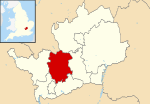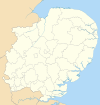St Albans City and District
City and District of St Albans | |
|---|---|
 St Albans Cathedral | |
 Flag | |
 St Albans shown within Hertfordshire | |
| Sovereign state | United Kingdom |
| Country | England |
| Region | East of England |
| Non-metropolitan county | Hertfordshire |
| Status | Non-metropolitan district, Borough, City |
| Admin HQ | St Albans |
| Incorporated | 1 April 1974 |
| Government | |
| • Type | Non-metropolitan district council |
| • Body | St Albans City and District Council |
| • Leadership | Leader & Cabinet |
| • MPs | Daisy Cooper (LD) Bim Afolami (C) |
| Area | |
| • Total | 62.23 sq mi (161.18 km2) |
| Area rank | 177 (of 309) |
| Population (mid-2019 est.) | |
| • Total | 147,095[1] |
| • Rank | 141 (of 309) |
| • Ethnicity | 90.9% White 4.1% S.Asian 1.7% Black 1.9% Mixed Race 1.4% Chinese or Other |
| Time zone | UTC0 (GMT) |
| • Summer (DST) | UTC+1 (BST) |
| ONS code | 26UG (ONS) E07000100 (GSS) |
| OS grid reference | TL148073 |
| Website | www |
The City and District of St Albans (/ˈɔːlbənz/) is a local authority district in Hertfordshire in the East of England region. The main urban settlements are St Albans and Harpenden. The council offices are in St Albans.
History[]
St Albans City and District is a non-metropolitan district and city created on 1 April 1974 as a merger of the Municipal Borough of St Albans, the Harpenden Urban District and most of St Albans Rural District. The municipal borough had had city status since 1877[2] and it was granted to the entire district by letters patent on 9 July 1974.[3]
Geography[]
The district is in the west of Hertfordshire, bounded on the north west by Luton, on the north east by North Hertfordshire, on the east by Welwyn Hatfield, on the south by Hertsmere, on the south west by Watford and Three Rivers and on the west by Dacorum. The largest urban settlement is St Albans, followed in size by Harpenden, with lesser settlements at Redbourn, Wheathamstead, London Colney, Chiswell Green and Bricket Wood. Nearby towns include Hatfield to the east, Welwyn Garden City to the northeast, Luton and Dunstable to the northwest, Hemel Hempstead to the west, Watford to the southwest and Borehamwood to the south.
Communications[]
The M1 motorway, the M25 motorway, the A414 road and A1081 road run through the district. There are rail routes to London St Pancras from St Albans City railway station and to Watford from St Albans Abbey railway station.
Governance[]
Local government responsibilities are divided among Hertfordshire County Council, St Albans City and District Council and local parish councils. Hertfordshire County Council is responsible for education, transport, fire and public safety, social care and libraries. The district council has a wide range of responsibilities including electoral services, health and safety, licensing, car parks, pollution control, allotments, arts, cemeteries, grounds maintenance, museums, parks and open spaces, markets, street cleaning, management and maintenance of council owned housing, the administration of housing benefits, planning applications, building control, local development framework and spatial planning.[4] Parish council responsibilities include allotments, youth projects, leisure facilities, open spaces, traffic calming and community transport schemes.[4]
District council[]
The main offices of St Albans City and District Council are in St Albans. There are 58 elected councillors, representing twenty electoral wards. 18 wards elect three councillors each; two elect two each. Since 2021, the Liberal Democrats have had control of the council. Its present (2021) composition is: Liberal Democrats – 30, Conservative – 23; Labour – 2; Green Party – 1; Independent – 2.[5] The party group leaders are: Liberal Democrats – Cllr Chris White; Conservatives – Cllr Mary Maynard; Labour – Cllr Katherine Gardner; Independent and Green – Cllr Simon Grover.[6]
| Party | Seats [5] | |
|---|---|---|
| Liberal Democrats | 30 | |
| Conservative | 23 | |
| Labour | 2 | |
| Green | 1 | |
| Independent | 2 | |
Electoral wards[]
The wards electing two members are denoted with an obelisk (†). The rest elect three members.
|
|
|
Electoral history[]
Elections to the council are held in three out of every four years, with one third of seats on the council being elected at each election. Since the first election in 1973, the Conservative party and the Liberal Democrats have had periods in control.[7] The Conservatives had a majority from 1973 to 1984, and then again from 1998 to 1991 after a period of no overall control. The Liberal Democrats won control in 1994 but lost their majority in 1999. They had control from 2006 to 2007 and from 2008 to 2011.[7] In the 2011 election the Conservatives took half the seats, with 29 councillors.[7][8] The Conservatives won a majority in the 2015 election which they held until 2019.[9] The Liberal Democrats regained control in the 2021 election, which was delayed from 2020 due to the COVID-19 pandemic.[10]
Mayoralty[]
St Albans has had a Mayor for over 450 years since the Charter of 1553. Under modern arrangements, there is an Executive Cabinet of eight senior councillors and the Mayor's role is purely ceremonial. A list of past Mayors is available on the St Albans City and District Council website.[11]
Parish councils[]
There are parish councils in Colney Heath, Harpenden, Harpenden Rural, London Colney, Redbourn, St Michael, St Stephen (including the villages of Chiswell Green and Bricket Wood), Sandridge and Wheathampstead. The town of St Albans is unparished[12] but local affairs are overseen by a City Neighbourhoods Committee.
| Parish | Council | Population (2011) | Area (2011) |
|---|---|---|---|
| Colney Heath | Colney Heath Parish Council | 5,962 | 1,119 hectares (4.32 sq mi) |
| Harpenden | Harpenden Town Council | 29,448 | 1,278 hectares (4.93 sq mi) |
| Harpenden Rural | Harpenden Rural Parish Council | 405 | 923 hectares (3.56 sq mi) |
| London Colney | London Colney Parish Council | 9,507 | 513 hectares (1.98 sq mi) |
| Redbourn | Redbourn Parish Council | 5,344 | 1,908 hectares (7.37 sq mi) |
| Sandridge | Sandridge Parish Council | 11,451 | 1,518 hectares (5.86 sq mi) |
| St Michael | St Michael Parish Council | 477 | 2,120 hectares (8.2 sq mi) |
| St Stephen | St Stephen Parish Council | 13,865 | 2,329 hectares (8.99 sq mi) |
| Wheathampstead | Wheathampstead Parish Council | 6,410 | 2,599 hectares (10.03 sq mi) |
| Total parishes | 82,869 | 14,307 hectares (55.24 sq mi) | |
| St Albans (unparished) | City Neighbourhood Committee | 57,795 | 1,811 hectares (6.99 sq mi) |
| St Albans City and District | St Albans City and District Council | 140,664 | 16,118 hectares (62.23 sq mi) |
Economy[]
The City and District of St Albans has a strong local economy, is an excellent location for rail, road and airports, and is seen by many employers[who?] as a desirable place to be. The District also benefits from the proximity of the University of Hertfordshire, based close by at Hatfield, which is one of the country's leading business orientated universities.
St Albans has a highly skilled workforce, with the 4th highest proportion of managers, senior officials and professional occupations in the country. Nearly half of working age residents have a degree or equivalent qualification. Average weekly earnings are £724.40, 44% higher than the national average.[13] The St Albans District has lower than average unemployment and the lowest in Hertfordshire.[13] 2.8% of residents are disabled or permanently sick, compared with 5–6% nationally.[13]
Deloitte, Spreadex, AECOM, PricewaterhouseCoopers and Premier Foods have offices in the district. Sainsbury's Retail Distribution Centre at London Colney employs over 600 staff.[14]
Demography[]
In 2001 St Albans City and District had a population of 129,005 (50.8% female, 49.2% male). The mid 2012 population estimate was 138,800. In 2001 there were 20.5% children, 64.5% people of working age (16–64) and 14.9% older people (65+).[13] 86.9% of St Albans residents are White British, 4.3% Other White, 2% Irish and 1.3% Bangladeshi. 71% identify as Christian, 24.1% as "no religion" or "religion not stated", 2.6% as Muslim and 0.9% as Jewish.[13]
Twin towns[]
St Albans is twinned with:[15]
 Fano, Italy
Fano, Italy Nyíregyháza, Hungary
Nyíregyháza, Hungary Nevers, France
Nevers, France Odense, Denmark
Odense, Denmark Worms, Germany
Worms, Germany Nieuwleusen, Netherlands
Nieuwleusen, Netherlands Sylhet, Bangladesh
Sylhet, Bangladesh
In addition, there are friendship links with:
Arms[]

|
|
See also[]
Coordinates: 51°47′N 00°20′W / 51.783°N 0.333°W
References[]
- ^ "Archived copy". Archived from the original on 25 May 2017. Retrieved 29 June 2019.CS1 maint: archived copy as title (link)
- ^ "No. 24502". The London Gazette. 11 September 1877. p. 5185.
- ^ "No. 46352". The London Gazette. 24 September 1974. p. 7920.
- ^ Jump up to: a b St Albans City and District Council website
- ^ Jump up to: a b "St Albans City & District Council". BBC News. Retrieved 9 May 2021.
- ^ "Your Councillors". St Albans City and District Council. Retrieved 1 June 2021.
- ^ Jump up to: a b c "St Albans". BBC News Online. Archived from the original on 28 March 2015. Retrieved 3 February 2015.
- ^ "England council elections". BBC News Online. 10 May 2011. Archived from the original on 25 September 2015. Retrieved 3 February 2015.
- ^ "Election results: Conservatives lose control in St Albans". BBC News Online. 3 May 2019. Retrieved 11 May 2021.
- ^ "Elections 2021: Hertfordshire councils change hands". BBC News Online. 9 May 2021. Retrieved 11 May 2021.
- ^ "Mayoral Count" (PDF). stalbans.gov.uk. Archived (PDF) from the original on 9 March 2016. Retrieved 7 April 2018.
- ^ "Archived copy" (PDF). Archived (PDF) from the original on 3 December 2013. Retrieved 28 November 2013.CS1 maint: archived copy as title (link)
- ^ Jump up to: a b c d e "Mapped: St Albans Community Profile". Archived from the original on 29 June 2012. Retrieved 1 September 2012.
- ^ Mapped: St Albans Economy Report 2011
- ^ "Archived copy". Archived from the original on 31 October 2013. Retrieved 28 November 2013.CS1 maint: archived copy as title (link)
- ^ "East of England Region". Civic Heraldry of England. Retrieved 9 March 2021.
External links[]
- City of St Albans
- Cities in the East of England
- Districts of Hertfordshire
- Politics of St Albans
- Local authorities in Hertfordshire

